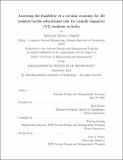Assessing the feasibility of a circular economy for 3D printed tactile educational aids for visually impaired (VI) students in India
Author(s)
Mandal, Indrayud Biswas
DownloadThesis PDF (5.352Mb)
Advisor
Keane, Kyle
Seering, Warren
Terms of use
Metadata
Show full item recordAbstract
Access to higher STEM education is limited to students with disabilities globally. The issue is particularly prevalent in countries like India where students are frequently advised against pursuing higher STEM education due to insufficient devices and tools in schools. The unavailability of educational devices in the sciences along with insufficient pay and attention for instructors in public schools results in a massive under-representation in higher education. Even for those who are brave enough to pursue their dreams, the statistics are incredibly bleak. 6 out of 10 students fail graduate classes in the visually impaired (VI) community because their fundamentals have not been built up sufficiently [6]. The present system results in few VI students pursuing science and technology as their academic and professional future. This results in a skewed participation in higher education and technology professions which has a direct consequence of accessibility being treated as an afterthought in product design globally.
The extent of this problem is not apparent to sighted individuals as they do not face the same challenges as their differently-abled counterparts. Furthermore, there is a segregation of these students from standard schools; thus, the interaction between both groups of students is minimal. Having such a large problem space, the focus of this study has been on targeting the issue of a single-disability (VI) and a single-subject (geometry). The solution involves tactile devices that can be easily integrated into the curriculum, such as tactile tangrams puzzles and the Hexa-compass.
Focus areas of this study have been analyzing the current curriculum and determining integration of the devices into the same. Furthermore, stakeholder analysis was conducted based on the REAP framework along with the determination of a technology strategy statement for the next five years from an ecosystem and technology perspective. This is a Blue Ocean Market analyzed using the Business Model Canvas, and a circular economy model has been piloted at Bengaluru and Chennai, India, in the past nine months. Finally, there is a recount of the challenges encountered, suggestions on future work, and a commentary on the more extensive socio-technical system.
Date issued
2021-09Department
System Design and Management Program.; System Design and Management Program.Publisher
Massachusetts Institute of Technology